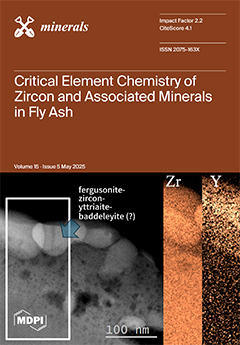The Cuyu gold deposit in central Jilin Province in Northeast China is located in the eastern segment of the northern margin of the North China Craton (NCC), as well as the eastern segment of the Xing’an–Mongolian Orogenic Belt (XMOB). Gold ore-bodies are controlled by NW-trending faults and mainly occur in late Hercynian granodiorite. The mineralization process in the Cuyu deposit can be divided into three stages: quartz + coarse grained arsenopyrite + pyrite (stage I), quartz + sericite + pyrite + arsenopyrite + electrum + chalcopyrite + sphalerite (stage II), and quartz + calcite ± pyrite (stage III). Stage II is the most important for gold mineralization. We conducted analyses including petrography, microthermometry, laser Raman spectroscopy of fluid inclusions, and H–O–S–Pb isotopic analysis to elucidate the mineralization processes in the Cuyu deposit. Five types of primary fluid inclusions (FIs) are present in the hydrothermal quartz and calcite grains of the ore: liquid-rich two-phase aqueous fluid inclusions (L-type), vapor-rich two-phase aqueous fluid inclusions (V-type), CO
2-bearing two- or three-phase inclusions (C1-type), CO
2-rich two- or three-phase inclusions (C2-type), and pure CO
2 mono-phase inclusions (C3-type). From stages I to III, the fluid inclusion assemblages changed from L-, C2-, and C3-types to L-, V-, C1-, C2-, and C3-types and, finally, to L-types only. The corresponding homogenization temperatures for stages I to III were 242–326 °C, 202–298 °C, and 106–188 °C, and the salinities were 4.69–9.73, 1.63–7.30, and 1.39–3.53 wt.% NaCl equiv., respectively. The ore-forming fluid system evolved from a NaCl-H
2O-CO
2 ± CH
4 ± H
2S fluid system in stage I and II with immiscible characteristics to a homogeneous NaC-H
2O fluid system in stage III. Microthermometric data for stages I to III show a decreasing trend in homogenization temperatures and salinities. The mineral assemblages, fluid inclusions, and H–O–S–Pb isotopes indicate that the initial ore-forming fluids of stage I were exsolved from diorite porphyrite and characterized by a high temperature and low salinity. The addition of meteoric water in large quantities led to decreases in temperature and pressure, resulting in a NaCl-H
2O-CO
2 ± CH
4 ± H
2S fluid system with significant immiscibility in stage II, facilitating the deposition of gold and associated polymetallic sulfides. The Cuyu gold deposit has a similar ore genesis to those of gold deposits in the Jiapigou–Haigou gold belt (JHGB) of southeastern Jilin Province indicating potential for gold prospecting in the northwest-trending seam of the JHGB.
Full article





